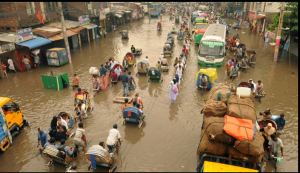High temperatures, stagnant air and an increase in smog have driven Los Angeles ozone pollution to its highest level since 2009.
Ozone—a gas in smog that triggers asthma and can cause lung damage—has exceeded the federal standard of 70 parts per billion in the LA region for 93 days in 2016, compared to 69 at this time last year.
“The weather has not been cooperating,” said Sam Atwood, spokesman for the South Coast Air Quality Management District, an area recently menaced by massive wildfires.
One ozone spike hit an alarming 164 parts per billion, a level not recorded since 2009, Atwood said.
He blamed the ozone increase on high temperatures and a lack of “atmosphere inversion”—air movements from high to low pressure areas that create wind and disperse pollution.
Los Angeles is notorious for its reliance on cars and home to two of America’s most active ports.
The city is also surrounded by mountains, obstructing air circulation and contributing to the stagnation of toxic emissions.
California’s expanding economy is also a factor, Atwood said.
“Our region continues to grow—we see more and more trucks on the road servicing the ports,” he said.
Atwood did say environmental analyses show “polluting emissions continue to decline,” thanks to stricter regulations, especially for large trucks.
Ports in Long Beach and Los Angeles have also instituted measures to favor cleaner electric power and reduce the speed of ships.
Analysts have not measured the impact of recent ozone spikes on human health, but Atwood said studies have shown that when ozone levels increase, so do the number of hospital admissions, especially for asthma attacks and cardiac problems.
This year’s poor air quality is cause for concern, but Atwood noted that three decades ago, “peak levels were three times as high, ”reports AFP.




